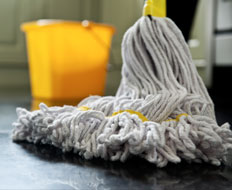September marks National Food Safety Month, a campaign that promotes the importance of food safety education for the restaurant and foodservice industry. With an estimated 48 million Americans (or roughly one in six people) becoming sick from foodborne diseases every year, according to the Centers for Disease Control and Prevention (CDC), it’s important to recognize the significance of a proper sanitation program.
During September and beyond, restaurants and fast-food chains should ensure they have an effective cleaning program in place to provide a hygienic environment for employees and patrons. This can be achieved by partnering with a cleaning supplier to create personalized solutions tailored to each franchise that optimize quality of cleaning and cost effectiveness. Ultimately, the goal of a relationship between a cleaning supplier and a restaurant is to both improve food safety and overall restaurant cleanliness, as well as customer-satisfaction scores.
To do this, quick-service restaurants can work together with a cleaning supplier in the following ways to improve their sanitation program:
Cleanliness Clues: The Sanitation Audit
A proper sanitation program begins with research. A cleaning supplier should first observe several restaurants in a fast-food chain, interview employees to identify difficult tasks, and look for opportunities for improvement inside and outside of the establishment. This detailed study can take place over one to two weeks.
Everything from outside cleanliness, kitchen equipment, and food contact surfaces to small wares, floors and drains, and bathrooms should be observed. Some of the cleaning challenges in these areas can stem from contaminated equipment; hardened, baked-on, or burnt-on soils; and greasy floors. Additionally, it’s important to take a look at hotspot areas that are common customer pet peeves, like visible soils and odors in bathrooms; sticky tables, chairs, and floors; and dirty condiment stands.
Personal hygiene should also be reviewed, as it can have a huge impact on food safety. Employees should be trained on when and how to wash their hands properly, and they must understand the importance of coming to work in good health to help stop the spread of germs. In addition, employee uniforms and clothing should be properly washed to avoid contamination.
A cleaning or sanitation audit can provide restaurants with new opportunities for cleanliness improvement in all areas of the establishment.
Choosing the Right Cleaning Products
There are many different types of surfaces and areas to clean to promote a hygienic environment. A cleaning supplier is a wonderful resource to help franchise operators choose cleaning products that get the job done right the first time.
Multipurpose products can clean and disinfect in just one step to save time and money. Typically, employee labor can account for up to 80 percent of cleaning costs. By working with a cleaning supplier, operators can reduce the amount of time and cost to clean a restaurant by using effective cleaning products and putting efficient cleaning processes into place.
With the variety of cleaning needs in a quick-service restaurant, from restrooms to kitchen equipment to countertops and floors, a cleaning supplier can recommend products that meet an operator’s unique needs and provide cost benefits.
Ultimately, using quality cleaning products that employees understand how and when to use can make a big difference in restaurant cleanliness and employee productivity.
Effective Training for Management and Staff
A cleaning supplier can also help customize a training program to ensure management and front-line employees have been equipped with the knowledge to move forward with cleaning recommendations. First, it’s important to train management on processes and procedures, as quick-service restaurants generally have a high turnover rate with front-line employees. Managers should be equipped to train and coach new and current employees.
There is a variety of training tools that can be successful in reaching restaurant employees, including training videos, in-store training, monitoring and feedback, and procedural wall charts that serve as reminders on how to do things correctly.
Quick-service restaurants should also work with their cleaning supplier to assist with local health standards. A cleaning supplier’s sanitation team should be well versed on procedures that are in line with health codes and able to help a restaurant investigate any health code violations to ensure compliance. A restaurant is more likely to be in compliance with health codes if it is working together with a trusted cleaning supplier.
By finding the right cleaning supplier that can offer education, training, and support, in addition to the products themselves, it can result in several benefits, including increased food safety, lower cleaning costs, increased efficiency and effectiveness, and improved customer cleanliness satisfaction scores.
Don’t forget to continue communicating and working with your supplier to regularly evaluate your program for continuous improvement.












